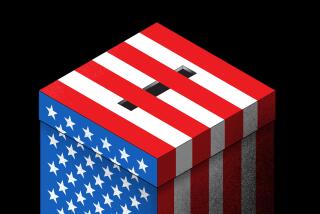Getting Started as President: a Holdover White House Staff Could Ease Transition
A prime minister taking office in Britain or Canada can turn to a permanent pool of civil servants for help getting started, but on his first day, a new President of the United States has only bare walls, empty files and bewildered subordinates.
Every piece of paper, every senior aide, every shred of evidence of a predecessor is gone. It has always been that way; it will be that way when Ronald Reagan leaves the White House. There is no institutional memory to bridge the gap in experience.
Stuart Eizenstat, who headed President Jimmy Carter’s domestic policy staff, favors installing a cadre of career civil servants with experience spanning several administrations, the way the British and Canadians do.
“One of the great gaps in the White House is the tremendous discontinuity in policy and lack of historical memory,” said Eizenstat. “No corporate (chief) would operate in an environment where he comes in and all of his vice presidents, all of his line staff are all new with him, none of them with prior experience.”
Heads Study Center
Eizenstat is a member of the Center for Excellence in Government, an organization of 300 former government managers that has ideas about how to ease transitions.
Concerned with how the next chief executive will handle the enormous task of making 3,000 political appointments to run his administration, the center has prepared a questionnaire for all candidates.
“A year from today we are going to swear a new President into office and the business of getting elected turns to the business of governing,” said Bill Morrill, president of the center. “Getting elected is one thing; governing is another.”
The questionnaire raises problems such as this:
“Many thoughtful observers argue that the skills required to manage a political campaign are very different than those required to manage high-level government jobs, yet many senior appointees ‘earn’ such appointments by having worked on the new President’s campaign. Should this practice be changed? If so, what rewards should campaign workers appropriately expect?”
An Overlooked Issue
Eizenstat concedes that the lack of institutional memory is not “a top-burner issue” with any of the men running for the White House, but he thinks it should be.
One solution, Eizenstat said, might be a small “White House secretariat” of 10 top-level civil servants who would not be gone with a change of administration.
The political issues, said Eizenstat, tend to be repetitive.
For example, “the Russians are going to do something outrageous during a 4-year term, and you are going to have to look at grain embargoes,” he said. “We have to get over this psychological hurdle that every President has--that everything in the White House, including the pictures and the waiters and everybody else, is somehow tainted.”
Lack of Background
He noted that two recent Presidents have had to deal with Iran, and both made similar mistakes. “Knowing what prior presidents have done and why they have done it” would be a great help, he said.
As an addition to the White House staff, the secretariat proposal would need congressional approval. And it would cost money. Eizenstat said he can name other, expendable government jobs that he would “trade one-for-one.”
Because some people fear that such a group would quickly become politicized and undermine a new President’s policy, Eizenstat said he would require 10 years of civil service for eligibility--experience that would span several administrations.
More to Read
Get the L.A. Times Politics newsletter
Deeply reported insights into legislation, politics and policy from Sacramento, Washington and beyond. In your inbox three times per week.
You may occasionally receive promotional content from the Los Angeles Times.






